
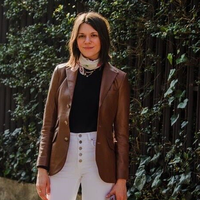
The RealReal, the quickly growing digital consignment store and fashion editors’ best-kept shopping secret, is now expanding its second-life fashion enterprise with its own original line. The debut collection consists entirely of upcycled pieces created in partnership with eight luxury brands: Balenciaga, Dries Van Noten, Stella McCartney, Jacquemus, Simone Rocha, Zero + Maria Cornejo, Ulla Johnson, and A-Cold-Wall.
Each of the more than 50 items in the ReCollection 01 line, which launched today, is made from unsellable pieces donated by the designer and reinterpreted by Atelier & Repairs, an L.A.-based workshop focused on perpetuating circular fashion. Unfinished American quilts act as the unifying design element, with Atelier & Repairs peppering bits of them onto each piece to cover or repair an imperfection.
The designer-selection process was an invigorating journey for the RealReal’s head of womenswear, Sasha Skoda. It included confirming sustainability-minded design veterans like Stella McCartney and Maria Cornejo and seeking out participation from customer favorites like Balenciaga and Jacquemus. Despite the excitement for the roster, it was approached with caution. “When thinking about the eight different designers that are so different from each other, we were a little bit concerned up front: How are we going to make this into one cohesive collection when the individual pieces themselves are so different and unique?” says Skoda. The quilts became the glue. “We loved the idea of it, because it was a concept of a single thread that’s creating a narrative between all the pieces, but it also goes back to the idea of American craftsmanship and quality and ‘handmade.’” While not all designers included are American, the sentiment is extended to the high quality associated with the brands’ names. “It’s something we really honor at the RealReal, in terms of luxury and craftsmanship, and these are the pieces that are going to have a really long lifespan and be able to be turned into other items that can live in different people’s closets for years.”
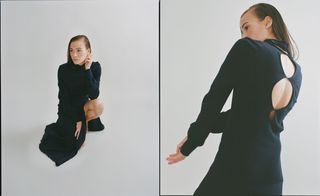
Jacquemus dress, upcycled by Atelier & Repairs, from the RealReal ReCollection 01, $595
The result is an entirely new one-of-a-kind item that maintains the integrity of the original creation while adding value to something that would likely be discarded otherwise. James Rogers, the RealReal’s director of sustainability, says this is essentially upcycling 101. “This is taking those items that would most likely be destined for the landfill or downcycling and actually upcycling them into newer items that have more value than the original. The value is subjective—that value could be artistic value or economic value—but it’s generally keeping [the piece] in its same form, for the most part, but making it new, versus downcycling it, where you’re taking the material, breaking it down, and turning it into something totally different, which uses a lot of energy and materials. [Downcycling] is still better than nothing, but [upcycling] is what we think is the best way to keep items out of the landfill.”
The pricing is consistent with consigned items from these brands on the RealReal, ranging from $195 to $2,450. The collection will be sold online, with a small selection available in the flagship store in New York’s SoHo neighborhood. A portion of the RealReal’s proceeds from sales of the collection will go to the environmental charity One Tree Planted. The RealReal previously partnered with the reforestation organization in October 2020 for an initiative with Gucci that offered a tree planted for each purchase and consignment of Gucci items.
Aside from a clearer conscience for the brands and the consumer, what does a partnership like this mean for the progress of sustainable efforts in the luxury industry? In a statement from the RealReal about the collection, Stella McCartney cements the idea of longevity as a focus for design: “As a designer, I think it’s the biggest compliment for your designs to have an afterlife. To me, that is luxury. And I take it into consideration from the beginning of the process. The timelessness of the design, how it’s made, what materials are used to produce it—it is all part of our ethos at Stella McCartney.”

Base Range bra, $59; Simone Rocha skirt, upcycled by Atelier & Repairs, from the RealReal ReCollection 01, $1,295; Bernard James necklace, $1,650; Brother Vellies socks, $35
While McCartney upholds an industry-wide reputation as a pioneer in sustainable luxury fashion, the participation of other brands that are at different stages of their sustainability journey will ultimately be what generates the buzz.
Shannon Welch, director of partnerships at climate-driven movement Fashion Revolution, sees this initiative as a catalyst for change in an industry that is fueled by keeping up with the Joneses. “I think this collection is going to make it cooler for luxury [brands] to start talking about and doing more in the sustainability space,” she says. But if a tree falls in the proverbial fashion forest, does it make a sound? “There are tons of luxury brands that may be doing great things; they’re just not talking about it. If you’re a leader in design and luxury in fashion and not taking some responsibility in sustainability, it’s a real shortcoming.”
But the tides definitely are turning. French luxury group Kering announced a $216 million backing of secondary market retailer Vestiaire Collective last month, in partnership with U.S. investment firm Tiger Global Management. In February, Alexander McQueen (under the Kering umbrella) became the first brand to collaborate with Vestiaire Collective via an initiative called Brand Approved that entices a select group of McQueen clients to sell authenticated pieces on the platform in exchange for a credit in store. The launch included a tartan skirt from Alexander McQueen’s Widows of Culloden Autumn/Winter 2006 show and a tuxedo vest from Sarah Burton’s first collection for the house, Spring/Summer 2011.
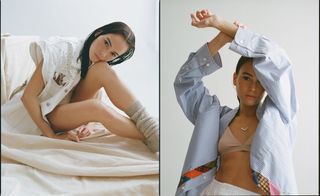
LEFT: Dries Van Noten vest, upcycled by Atelier & Repairs, from the RealReal ReCollection 01, $745; Richer Poorer top, $34; Brother Vellies socks, $35. RIGHT: Balenciaga shirt, upcycled by Atelier & Repairs, from the RealReal ReCollection 01, $525; Base Range bra, $59; Lorenzo Uomo boxers, $18; Bernard James necklace, $1,650
Welch appreciates that these big-name brands want to be involved in this conversation but believes much more must be done. “While this is a good way for a lot of the brands to tackle and take care of their waste problem, it is low-hanging fruit,” she says. She stresses the importance of corporate luxury fashion not using upcycling or partnering with secondary-market retailers on a small scale as a quick out. “[The RealReal’s collection] is going to bring attention to all brands that you need to be tackling your waste problem, and here’s an easy way to do it,” Welch says. She adds, “Now, once you do that, think about how to reduce your production to only sell or make what is needed. Then look at where you’re sourcing your material and who is making your clothes, and build a plan from there.”
And it’s not solely brands that should be held responsible for supporting this messaging; fashion media also plays a strong role as the gatekeepers of what’s in and out of style. “It’s probably too late to be having this conversation now,” says Rebecca Ramsey, a Los Angeles–based stylist and former fashion director of New York magazine. She believes fashion for photo shoots shouldn’t be limited to the runway samples of current collections that designers are loaning in exchange for press. “Sadly, a lot of publications don’t have budgets to rent vintage anymore. It’s such a shame because that’s where you get the ideas to tell stories.”
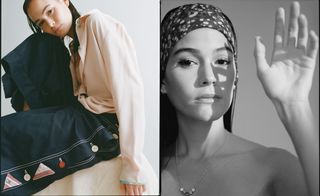
LEFT: Stella McCartney shirt, upcycled by Atelier & Repairs, from the RealReal ReCollection 01, $395, and pants, $495; Eres bra, $355; Bernard James necklace, $1,650. RIGHT: Ulla Johnson scarf, upcycled by Atelier & Repairs, from the RealReal ReCollection 01, $295; Bernard James necklace, $1,650
As a staff editor, there are obligations to support certain brands, but as a freelance editor she feels less bound to them. “For me and my work, it was always about newness (and oftentimes it still is), but now I have more of an opportunity to ask if there’s a budget for vintage rentals or if we can use older seasons. I love anytime I get to work with [talent] and use their own items. It’s a chance for them to extend their own personal style and talk about themselves in a visual way, and it can still be very stylish and part of the storytelling factor.” She goes on to stress that the authenticity of the wardrobe in a portrait or fashion spread is more than just the beauty of the clothing used, and the same goes for how we get dressed as individuals. “With styling, it’s not about the exact pieces. It’s more about the idea and how you’re putting yourself forward to say something.” Aligning with the secondary fashion market is not just a tool fashion stylists and editors use to sell merchandise, it’s also a way to send a message of industry approval. “I think it’s a verbal cue that you’re tapped in on this movement and you want to be part of it also.”
As fashion has proved over time, what’s new is old and what’s old is new again. Which, ironically, makes perfect sense for circular fashion and an industry that embraces innovation in many other ways. So why has it taken so long for upcycling to be celebrated? Luxury brands and fashion media embracing change will always be met with trepidation. Rogers says it best: “For some designers, this is just new, and new can be scary.”

Zero + Maria Cornejo dress, upcycled by Atelier & Repairs, from the RealReal ReCollection 01, $545
Photographer: Kathryn Wirsing | Stylist: Milton Dixon III | Model: Lohelani Hicks at State Mgmt | Hair & Makeup: Angel Gabriel at See Management for Chanel and T3
Stay In The Know
Marie Claire email subscribers get intel on fashion and beauty trends, hot-off-the-press celebrity news, and more. Sign up here.
Julia Gall is the former Style Director at Marie Claire, covering all things fashion, as well as styling tips, wardrobe upkeep and sustainability. Check her out at @juliasgall.
-
 Does Katie Holmes Have a New Favorite Shoe Trend?
Does Katie Holmes Have a New Favorite Shoe Trend?She swapped her usual sneakers for $150 Mary Janes.
By Halie LeSavage Published
-
 Nicola Peltz Beckham Skipped Her Mother-in-Law Victoria Beckham’s 50th Birthday Party—But There’s a Reason
Nicola Peltz Beckham Skipped Her Mother-in-Law Victoria Beckham’s 50th Birthday Party—But There’s a ReasonThe nonexistent Nicola/Victoria feud continues to not exist.
By Rachel Burchfield Published
-
 Hugh Grant Is More Than Ready for the Next 'Bridget Jones' Movie
Hugh Grant Is More Than Ready for the Next 'Bridget Jones' MovieThe fourth movie might just be the best of the entire series.
By Meghan De Maria Published
-
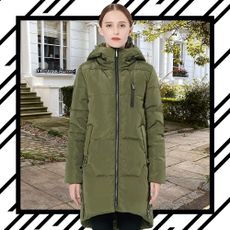 This Under-the-Radar Jacket on Amazon Is My Newest Winter Obsession
This Under-the-Radar Jacket on Amazon Is My Newest Winter ObsessionAnd, no, it's not the "Amazon coat."
By Jaimie Potters Published
-
 11 Graphic T-Shirts From Amazon You'd Actually Wear
11 Graphic T-Shirts From Amazon You'd Actually WearCheeky, not cheesy.
By Marina Liao Published
-
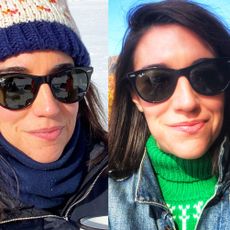 What I Wear on Repeat: Ray-Ban's Wayfarer II Sunglasses
What I Wear on Repeat: Ray-Ban's Wayfarer II SunglassesThe Wayfarer II comes in a variety of colorways, though I chose black frames (KMidd on the other hand favors tortoise) for ultimate throw-them-on-and-go capabilities.
By Sally Holmes Published
-
 Your Complete Guide to Winter Coats, From Puffers to Parkas
Your Complete Guide to Winter Coats, From Puffers to ParkasOur editors tapped experts for insight and hand-picked the 24 best options.
By Sara Holzman Published
-
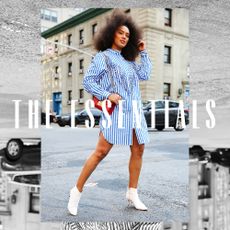 The 16 Best Shirtdresses to Wear With Everything
The 16 Best Shirtdresses to Wear With EverythingRefresh your wardrobe with a single item.
By Aya Kanai Published
-
 The 10 Best Espadrilles for Spring and Summer 2023
The 10 Best Espadrilles for Spring and Summer 2023Your chunky-phobia, cured.
By Sara Holzman Published
-
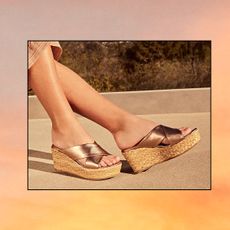 The 11 Most Comfortable Shoe Brands, According to Editors and a Podiatrist
The 11 Most Comfortable Shoe Brands, According to Editors and a PodiatristThe only shoes more comfortable than our house slippers.
By Gabrielle Ulubay Published
-
 The 10 Best Slip Dresses of 2024
The 10 Best Slip Dresses of 2024The humble slip dress could be the most versatile dress you own.
By Brooke Knappenberger Published